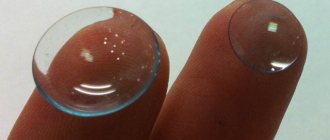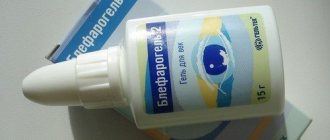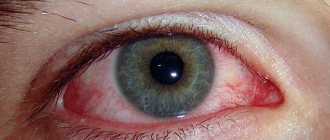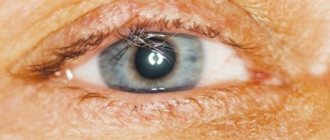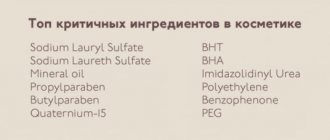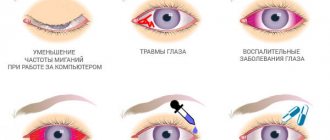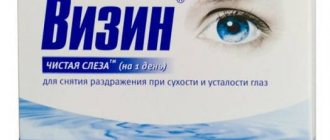An occluder is a patch on the eye. It usually repeats the shape of the eye socket, only with some allowance that extends the edges of the patch beyond its limits. The top of the occluder is glued above the eyebrow, the bottom - on the upper cheekbone.
In ophthalmology, it serves as a special opaque optical device designed to temporarily prevent one eye from working. And at this time the second one had an increased load. So that by working, he returns to normal, getting rid of pathologies such as strabismus or amblyopia, which is also called “lazy eye syndrome.”
When to use an occluder
The vast majority of cases of strabismus and amblyopia are observed in childhood. Strabismus in the first months of life is expressed more clearly and can be detected both with the usual careful examination of the baby’s behavioral reactions and by the direction of gaze.
By the way, it is easier to correct strabismus in early childhood. If, for some reason, the disease had to be corrected at an older age, it is less amenable to treatment.
We advise you to read: Computer vision syndrome, which develops against the background of prolonged work at the monitor, can be solved using the Visotronic device.
Strabismus can be called more of a mechanical defect in which the synchronous functioning of the eyes is disrupted. Because of this, both eyes cannot fixate on the object being viewed at the same time.
The causes of amblyopia most likely lie in the plane of a central nervous system disorder, when the visual analyzer in the “eye-optic nerve-brain area responsible for pattern recognition” system does not work well.
Often the very fact of strabismus provokes the occurrence of all the symptoms inherent in amblyopia. Visual acuity decreases, which gradually leads to an even greater deviation of the muscles that control the eyeball.
From such a deviation, the eye further loses its ability to maintain the correct position relative to the optical axis. The result is a vicious circle that cannot be broken without treatment.
Constant wearing
The effectiveness of treatment depends on whether adults can convey to the baby the importance of strict, constant wearing of the occluder.
For example:
- The patch was peeled back and the child looked at the world with both eyes for a couple of minutes - which means that the whole day of previous wearing of the patch was wasted.
- The child blew up the occluder for the sake of binocular vision for 6-10 minutes - you lost a week of treatment.
- Admiring your surroundings with both eyes for two to three hours will cancel out a month of exposure to the occluder.
- And the absence of a bandage on the eye for a whole year will mean that six months of the therapeutic effect of the patch were in vain.
Therefore, often treatment with these devices begins at a conscious age (which occurs differently in different children) - it can be 5 years, or 7, or 8. Or they use devices with a strong adhesive effect, which the child cannot remove on his own .
This option is preferable because the earlier treatment for strabismus or amblyopia is started, the more effective it will be. Treatment methods other than wearing a patch: surgical, medicinal, hardware.
Other Applications
- Providing emergency care for eye injuries, including penetrating injuries.
- As a postoperative dressing to protect the surgical field from external adverse influences.
Features of application
For children
In childhood, it is recommended to use occluder patches.
Keep in mind! This is explained by the fact that children, even with visual impairments, strive for a mobile, active lifestyle, and the device on glasses (like the glasses themselves) is always subject to damage.
In addition, young children who do not understand the need for such a device may dislodge the occluder from the lens, neglect to wear glasses, or wear them in a way that allows them to peek.
In such cases, the device does not fully perform its functions and vision is not restored.
An occluder patch is the best option.
In this case, such a product must be glued to the healthy eye, and if the disturbances affect both organs of vision, the device is worn on different eyes alternately.
The daily wearing time of the product should be an average of six hours.
But if the child is old enough and understands the importance of such therapy, and wearing the patch does not cause him any discomfort, the patch can be worn all day, removing it only at night.
Need to know! Depending on the severity of strabismus and amblyopia, the total period of wearing the occluder varies from several weeks to several years.
But regardless of this period, it is important to wear the product daily , since even breaks of a couple of days can reduce the positive effect of such therapy to a minimum.
For adults
For adult patients, it is more convenient and expedient to use overhead occluders.
The duration of their use, as in children, depends on the severity of the disease.
But the product should be used for 5-8 hours per day if possible .
If it is possible for adults to wear occluder patches in severe cases, it is recommended not to remove them even at night.
Varieties
The functionality of children's and adult occluders is the same. The only difference is in the design of the patches or covers with slots that are worn on glasses. The material of the occluders is the same for both.
They differ in material:
- Fabric, structurally reminiscent of a cover worn on the right or left frame of glasses. Such cases are among the most budget-friendly types of occluders.
- Breathable patches applied to the skin around the eye socket. They are hypoallergenic and ideally cover the entire field of vision of the eye being covered. But you have to pay a higher price for ease of wearing; these devices, despite their disposability, are expensive.
- Silicone. They have suction cups to secure the occluder on the inside of the glasses lens. They are an intermediate price option between fabric patches.
Children's occluders are divided by size into “mini” - worn by children under 2 years old, “midi” for 2-4 years, and “maxi”, for children over 4 years old. However, everything is individual and depends on the anatomical features of the facial bones, which is why the selection of occluders should be entrusted to a doctor.
Characteristics required for occluders used in the case of pathologies:
- Breathability with simultaneous ability to filter respiratory infections.
- Reliability of fastening.
- Possibility of selection in accordance with the type of face and shape of the eye socket.
- Painless removal of the patch.
The selection of devices for the correction of strabismus or amblyopia may also depend on the type of glasses frame - if fabric or silicone covers are used.
Why do adults need it?
But since in adults the treatment of strabismus or lazy eye syndrome only with the help of occluders is problematic, these devices are mainly used in the postoperative period. Their main function in such cases is to protect the wound from dirt and infections.
The occluder for adults can be used not only for medicinal, but also for cosmetic purposes. Their ability to both allow air to pass through, allowing the delicate skin of the eye sockets to “breathe,” and to moisturize the eyelids is ideal for this. To do this, the area adjacent to them is impregnated with a special therapeutic-moisturizing composition, which contains vitamins, lipins, proteins and microelements.
As a result of exposure to such a patch over a certain period of time, the fine mesh of age wrinkles becomes almost invisible.
There are also very expensive cosmetic and health occluders with pearl powder, placenta extract, retinol and other similar substances.
The third type is draining. Such patches relieve swelling of the eyelids and under the eyes.
What is it needed for
Strabismus can be different: according to the deviation of the parallelism of the axes of vision - vertical, divergent and convergent; by the nature of development - acquired or congenital; in form - photoparalytic (arising after diseases of the optic nerve or oculomotor muscles) and conjugate (both eyes squint alternately). The reasons for the development of strabismus are:
- inflammatory or other pathological processes in the muscles of the organs of vision;
- runny nose;
- brain diseases of a post-traumatic or infectious nature;
- severe visual, nervous, physical overload;
- birth injuries, premature newborns;
- genetic predisposition;
- chronic process of visual impairment due to untimely treatment.
Symptoms of strabismus are manifested in the inability to simultaneously track an object with both eyes, twitching of the eyeballs, closing one of the eyes to examine nearby or distant objects, and incomplete raising of one of the eyelids. Eyes can look in different directions. It is necessary to get rid of the problem at the time of its onset; treatment begins after a year of life using occluders.
They can be used alone or in combination with correction glasses prescribed by an ophthalmologist. The patches activate the squinting eye, and deviations in the functioning of the visual apparatus are corrected over time. The use of special products is convenient, safe, and effective. In addition to strabismus, patches are used for amblyopia - lazy eye syndrome.
This condition is characterized by insufficient functioning of one eye, but no significant changes are observed in it. The cause of amblyopia is a strong difference between the images seen by both eyes. The brain cannot combine them into one image, so the body suppresses the work of one eye, transferring the entire visual load to the other. The occluder helps to make both eyes work.
Best Occluder Brands
Ortopad (Italy)
It is a patch with a hypoallergenic adhesive layer along the edge, which reliably fixes the product in the eye socket. To tear it off during games or when adults are not looking, the child needs to work hard. However, Ortopad occluders have a bright, “fun” design, funny patterns and colors, and children are rarely tempted to damage the integrity of the patch, which is highly breathable and does not give any discomfort throughout the entire day of wearing.
Opticlude (Poland)
Made from non-woven porous viscose. They are also available in the form of patches glued to the eye socket. The patches are hypoallergenic; there have been no cases of skin irritation during use. The view is completely blocked. They are decorated with bright ornaments or themed pictures with funny scenes.
ORTOPAD – incomparable benefits and an exciting game
The baby's tastes do not always coincide with the preferences of the parents. Therefore, a child may often be capricious and not want to constantly wear an eye trainer.
Experts have found a way out of this situation. The brand's products were developed by highly qualified ophthalmologists and designers who took into account the requirements of parents and the tastes of children. Children took part in the process of searching for the desired shape, color, and design. The guys portrayed their favorite characters (fish, kittens, pirates, monsters, princesses and other heroes). The top outer layer is designed in a children's style, which turns wearing the patch into an interesting game. The manufacturer offers to purchase an occlusive patch for boys and girls. The range includes universal models that are suitable for children of both sexes.
The use of game moments in treatment with occluders
Convincing a child to wear an occluder over the eye is not an easy task. While he gets used to the disturbance, whims and even hysterics are possible. Attempts to “play pirates” by simply blindfolding him with a black bandage will lead to rapid fatigue from the same role.
Therefore, when choosing patches, you need to focus on their decorativeness, colorfulness, and unusual design. Packaging for disposable products is particularly good in this regard. Funny and bright drawings on them will help convince the child that with such decoration on his eye he will look the best.
Features of application
The younger the child, the greater the likelihood that parents will choose a patch to correct visual impairment. And not silicone or fabric overlays for lenses and frames of glasses.
Primarily due to the restlessness, activity or even hyperactivity of children. Both the occluder pads and the glasses themselves can be damaged. Another thing is a patch that replicates the anatomical features of the child’s face.
Another argument in favor of this choice is the reliability of the adhesive layer applied to the edge of the occluder: properly and carefully smoothed along this edge by adults, it will not just come off, even with some effort on the part of the little fidget.
Occluders: who are they for?
Rice. ASD
What is an atrial septal defect?
In a normal heart, the right and left sections are separated from each other by a thin wall, the so-called septum. An atrial septal defect is a hole between the chambers of the heart - the left and right atria. The pressure in the left chambers of the heart is normally higher than in the right. Blood from the left atrium enters the right atrium, then into the right ventricle and pulmonary artery, causing stretching and overload of these parts of the heart. This in turn leads to a number of unpleasant problems.
The pressure in the left chambers of the heart is normally higher than in the right. Blood from the left atrium enters the right atrium, then into the right ventricle and pulmonary artery, causing stretching and overload of these parts of the heart. This in turn leads to a number of unpleasant problems.
What will atrial septal defect lead to?
The right ventricle and right atrium, overloaded with blood, increase in size, which leads to disruption of the heart, the development of heart failure and various arrhythmias. The defect is manifested by shortness of breath, a constant feeling of fatigue, and in advanced cases - swelling and a feeling of interruptions in the functioning of the heart. Blood overload of the pulmonary artery leads to the development of frequent bronchopulmonary diseases, and in advanced cases – to irreversible changes in the pulmonary vessels, their sclerosis. In such cases, closure of the atrial septal defect is contraindicated.
What is a patent foramen ovale?
Some healthy people have a small gap between the atria called a patent foramen ovale. The fetus has such a gap in the womb and, as a rule, it closes on its own in the first few months of life. A patent foramen ovale is not a malformation and does not lead to the development of the symptoms that appear with an atrial septal defect. Quite rarely, in adults, a patent foramen ovale can lead to the development of sudden cerebral thromboembolism (stroke in young people). Only in this case does a patent foramen ovale require endovascular closure.
Rice. Treatment of LLC with an occluder
Treatment of atrial septal defect
The indication for the operation is overload and enlargement of the right chambers of the heart. The optimal age for surgery for uncomplicated cases is preschool age. In the case of a large atrial septal defect, significant blood discharge, or when symptoms of heart failure appear and increase, surgery should be performed regardless of the patient’s age. Today, there are two ways to close defects: the endovascular method and surgery under artificial circulation (suturing the ASD or closing it with a patch).
Endovascular closure of ASD
In the last two decades, devices have appeared that make it possible to close an atrial septal defect without resorting to open intervention, which requires an incision, artificial circulation and long-term rehabilitation. The essence of endovascular treatment is the introduction of an intravascular device - an occluder , bringing them through the vascular bed to the area of the identified pathology and using them to carry out various treatment procedures.
Rice. 2 Appearance of the occluder
Rice. 3 Occluder on delivery system
Rice. 4 The occluder can stretch and deform, but in the heart it will take the shape we need
Rice. 5 The delivery system is inserted into the femoral vein
The device consists of two disks made of nitinol (an alloy of titanium and nickel elements, has a shape memory effect), filled with thin threads of Dacron (a synthetic polymer). When folded, the occluder is located in a thin tube - a catheter.
The materials from which the occluder is made are completely biocompatible and hypoallergenic and do not have magnetic properties. Endovascular intervention is performed in a cath lab. Before endovascular closure of an atrial septal defect, all patients undergo transesophageal ultrasound examination of the heart (ultrasound). Since our heart is located directly behind the esophagus, transesophageal ultrasound provides complete information about the anatomy of such a heart defect.
Dr. BOSTI recommends COCOON occluders (Vascular Innovations Co., Ltd) . You can view them on our website and purchase one of four types of this device.
Types of COCOON occluders:
1) Cocoon PFO - occluder for closing the oval window in the middle part of the interatrial septum
2) Cocoon Duct - occluder for closing the patent ductus arteriosus
3) Cocoon Septal - occluder for closing defects in the upper and lower parts of the interatrial septum
4) Cocoon VSD - occluder for closing ventricular septal defects in the membranous, muscular parts and for eliminating septal aneurysms
Occluders in the treatment of strabismus
Occluders are often an adjunct to medical or surgical treatments. In these cases, one squinting eye is affected by special computer programs or laser stimulation. Such methods are called pleoptic.
In contrast, there are orthoptic treatment methods, in which synoptic devices and laser radiation affect both eyes.
Along with occluders covering the diseased eye, ophthalmologists almost always practice the use of conservative hardware treatment, with a frequency of 2 to 4 times a year. In practice, this looks like continuous use of an occluder for 2 to 6 months in a row, alternating with the use of devices. To correct pathologies, computer images with a special display algorithm and laser exposure are used.
The second stage, after visual acuity has improved, will be treatment to restore connections between the eyes.
The next stage, restoring visual binocular balance, may include (although not necessarily, it depends on the complexity of the disorders) surgical intervention.
The last will be the restoration of three-dimensional, stereoscopic vision, without which accurate eye measurement with an assessment of the size of objects and distances to them is impossible.
Surgical interventions are resorted to only in cases where all other measures used for one and a half to two years have not been effective. And you need to keep in mind that complete elimination of strabismus without surgery is possible only in childhood, when the body’s adaptive reserves are great.
Treatment of amblyopia
Treatment of amblyopia with occluders will be more effective the earlier it begins.
The prognosis is made based on the severity of the disease and the timing of its onset at an early age.
In the treatment of amblyopia, the effect of neuroplasticity of visual reactions is also used, in which gradual improvements in vision are deposited in the conscious and subconscious mind.
This is done using a special computer program, showing created “stimuli” based on the Gabor spot. With an occluder on the eye, with the inclusion of a “blind spot” on the surface of the retina of the other, consciousness completes an incomplete image to hide the interference. The reconstructed, imaginary image for perception turns out, in spite of everything, to be quite real.
In the case of joint use of special hardware methods and an eye patch, the rule “after 12 years it is too late to treat” does not work. Moreover, with the use of surgical treatment methods.
Diagnostics before prescribing an occluder
To identify indications for using a bandage, it is recommended to undergo preliminary diagnostic tests:
- Collecting anamnesis of the patient or his close relatives. Parents may complain that the child is unable to see distant objects and has developed a squint in one of the eyes.
- Examination of the superficial structures of the eyeballs. The test can detect obvious strabismus.
- Fundus examination. To do this, Atropine or similar agents are instilled. The doctor examines the fundus of the eye, evaluates the structure of the internal elements, and identifies abnormalities.
- Assessing the presence or absence of binocular vision.
- Assessment of the accommodative ability of the eyeballs.
- Measuring the angle at which the strabismus formed.
- Determination of the refractive power of the cornea and lens.
- Assessment of color perception using diagnostic tables or semi-automatic analyzers.
- Determination of the boundaries of the field of view for which a semi-automatic analyzer is used (ophthalmic perimeter). The negative side of the technique is the impossibility of determining the visual perimeter for young children.
Additionally, the ophthalmologist may advise parents to consult a neurologist. It is possible to identify congenital neurological disorders due to which vision function has been altered. In this case, it will be necessary to treat the primary disease and additionally wear an occluder to completely eliminate the risk of relapse.
